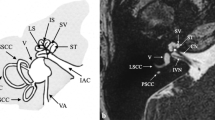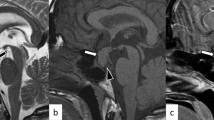Abstract
Ecchordosis physaliphora (EP) is a distinct clinical entity defined as a notochordal remnant found on the dorsal surface of the clivus, occurring in about 2 % of autopsies. The aim of this study is to introduce typical and atypical imaging features of EP, which can be confused with those of clival chordoma. Forty-one patients with clinical suspicion for clival chordoma visited the outpatient clinic from June 2007 to August 2015. A retrospective review was performed with magnetic resonance imaging (MRI) and computed tomography (CT) studies to revise the diagnosis to EP. Eight of 41 patients (19.5 %) manifested lesions on the dorsal surface of the clivus that were well circumscribed and homogenous, with no septations or osteolysis. The lesions were all hypointense on T1, hyperintense on T2-weighted MRI, and had no enhancement with gadolinium. A distinct T2-hypointense pedicle, which is the hallmark of EP, was seen in five patients (62.5 %) and defined as typical EP. A characteristic T2-hypointense rim was observed in three patients and defined as atypical EP (37.5 %). The mean largest diameter of the lesions was 1.1 cm (0.6–1.8 cm). Lesion size did not change in all the patients who were followed for a mean of 3.6 years (1.4–8.2 years) by separate MRI scans performed every 6 months to 1 year. EP and clival chordoma represent different spectra of the same pathology. As the two lesions have completely different prognoses, precise knowledge of the imaging features of EP is very important. Accurate diagnosis is essential for proper treatment planning.





Similar content being viewed by others
References
Alkan Ö, Yildirim T, Kizilkilic O et al (2009) A case of ecchordosis physaliphora presenting with an intratumoral hemorrhage. Turk Neurosurg 19:293–296
Burger PC, Scheithauer BW, Vogel FS (2002) Surgical pathology of nervous system and its coverings. Churchill Livingstone, New York, pp 23–26
Cha ST, Jarrahy R, Yong WH, Eby T, Shahinian HK (2002) A rare symptomatic presentation of ecchordosis physaliphora and unique endoscope-assisted surgical management. Minim Invasive Neurosurg 45:36–40
Chihara C, Korogi Y, Kakeda S et al (2013) Ecchordosis physaliphora and its variants: proposed new classification based on high-resolution fast MR imaging employing steady-state acquisition. Eur Radiol 23:2854–2860
Ciaparglini R, Pasquini E, Mazzatenta D et al (2009) Intradural clival chordoma and ecchordosis physaliphora: a challenging differential diagnosis: case report. Neurosurgery 64:387–388
Dow GR, Robson DK, Jaspan T et al (2003) Intradural cerebellar chordoma in a child: a case report and review of the literature. Childs Nerv Syst 19:188–191
Francasso T, Brinkmann B, Paulus W (2008) Sudden death due to subarachnoid bleeding from ecchordosis physaliphora. Int J Legal Med 122:225–227
Golden LD, Small JE (2014) Benign notochordal lesions of the posterior clivus: retrospective review of prevalence and imaging characteristics. J Neuroimaging 24:245–249
Gonzalez-Martinez JA, Guthikonda M, Vellutini E et al (2002) Intradural invasion of chordoma: two case reports. Skull Base 12(3):155–161
Ho KL (1985) Ecchordosis physaliphora and chordoma: a comparative ultrastructural study. Clin Europathol 4:77–86
Horten BC, Montague SR (1976) Human ecchordosis physaliphora and chick embryo notochord. Virchows Arch A Pathol Anat Histol 371:295–303
Ito E, Saito K, Nagatani T et al (2010) Intradural cranial chordoma. World Neurosurg 73:194–197
Lantos PL, Louis DN, Rosenblum MK, Kleihues P (2002) Tumours of the nervous system. In: Graham DI, Lantos PL (eds) Greenfield’s neuropathology, vol 2, 7th edn. Arnold, London, pp 767–1052
Ling SS, Sader C, Robbins P et al (2007) A case of giant ecchordosis physaliphora: a case report and literature review. Otol Neurotol 28:931–933
Macdonald RL, Cusimano MD, Deck JH, Gullane PJ, Dolan EJ (1990) Cerebrospinal fluid fistula secondary to ecchordosis physaliphora. Neurosurgery 26:515–519
Mapstone T, Kaufman B, Ratcheson R (1983) Intradural chordoma without bone involvement: nuclear magnetic resonance (NMR) appearance—case report. J Neurosurg 59:535–537
Masui K, Kawai S, Yonezawa T et al (2006) Intradural retroclival chordoma without bone involvement. Neurol Med Chir (Tokyo) 46:552–555
Mehnert F, Beschorner R, Küker W, Hahn U, Nägele T (2004) Retroclival ecchordosis physaliphora: MR imaging and review of the literature. Am J Neuroradiol 25:1851–1855
Ng SH, Ko SF, Wan YL, Tang LM, Ho YS (1998) Cervical ecchordosis physaliphora: CT and MR features. Br J Radiol 71:329–331
Nishigaya K, Kaneko M, Ohashi Y, Nukui H (1998) Intradural retroclival chordoma without bone involvement: no tumor regrowth 5 years after operation—case report. J Neurosurg 88:764–768
Ozgür A, Esen K, Kara E et al (2014) Ecchordosis physaliphora: evaluation with precontrast and contrast-enhanced fast imaging employing steady-state acquisition MR imaging based on proposed new classification. Clin Neuroradiol. doi:10.1007/s00062-014-0361-z
Roberti F, Sekhar LN, Jones RV et al (2007) Intradural cranial chordoma: a rare presentation of an uncommon tumor. J Neurosurg 106:270–274
Rodriguez L, Colina J, Lopez J, Molina O, Cardozo J (1999) Intradural prepontine growth: giant ecchordosis physaliphora or extraosseous chordoma? Neuropathology 19:336–340
Ross JS, Brant-Zawadzki M, Moore KR, Crim J, Chen MZ, Katzman GL (2004) Diagnostic imaging: spine. Salt Lake City, Utah
Sarasasa JL, Fortes J (1991) Ecchordosis physaliphora: an immunohistochemical study of two cases. Histopathology 18:273–275
Sassin JF (1975) Intracranial chordoma. In: Vinkin PJ, Bruyn GW (eds) Handbook of clinical neurology, vol. 18, tumours of the brain and skull, part III. Elsevier, New York, pp 151–164
Stam FC, Kamphorst W (1982) Ecchordosis physaliphora as a cause of fatal pontine hemorrhage. Eur Neurol 21:90–93
Tashiro T, Fukuda T, Inoue Y et al (1994) Intradural chordoma: case report and review of the literature. Neuroradiology 36:313–315
Toda H, Kondo A, Iwasaki K (1998) Neuroradiological characteristics of ecchordosis physaliphora. J Neurosurg 89:830–834
Willis RA (1967) Pathology of tumours, 4th edn. Appleton, New York, pp 937–938
Wolfe JT III, Scheithauer BW (1987) “Intradural chordoma” or “giant ecchordosis physaliphora”? Report of two cases. Clin Neuropathol 6:98–103
Yamaguchi T, Suzuki S, Ishiiwa H et al (2004) Benign notochordal cell tumors: a comparative histological study of benign notochordal cell tumors, classic chordomas, and notochordal vestiges of fetal intervetebral discs. Am J Surg Pathol 28:756–761
Acknowledgments
This study was supported by a faculty research grant funded by the Yonsei University College of Medicine (6-2014-0060).
Author information
Authors and Affiliations
Corresponding author
Ethics declarations
The institutional review board approved the study, which was conducted in accordance with the ethical guidelines of the Declaration of Helsinki.
Disclosure
The authors have no financial interests in the materials, nor did they receive any support related to the materials or manufacturers described in this article.
Conflict of interest
The authors declare that they have no conflict of interest.
Rights and permissions
About this article
Cite this article
Park, H.H., Lee, KS., Ahn, S.J. et al. Ecchordosis physaliphora: typical and atypical radiologic features. Neurosurg Rev 40, 87–94 (2017). https://doi.org/10.1007/s10143-016-0753-4
Received:
Revised:
Accepted:
Published:
Issue Date:
DOI: https://doi.org/10.1007/s10143-016-0753-4




